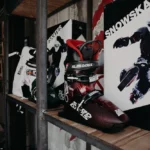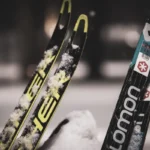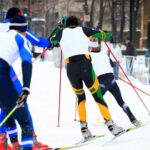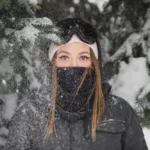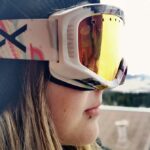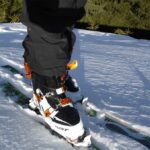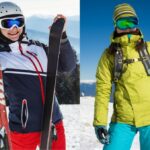Skiing is an activity that is quite difficult to plan for when it comes to appropriate clothing, and it’s not only because the weather at high altitudes is volatile and liable to sudden unexpected changes.
Skiing is typically a snowsport, and as such most people would just simply think to wrap up warm and not pay much attention to the clothing they wear or how they wear it. This is a huge mistake and can be as dangerous as it is discomforting.
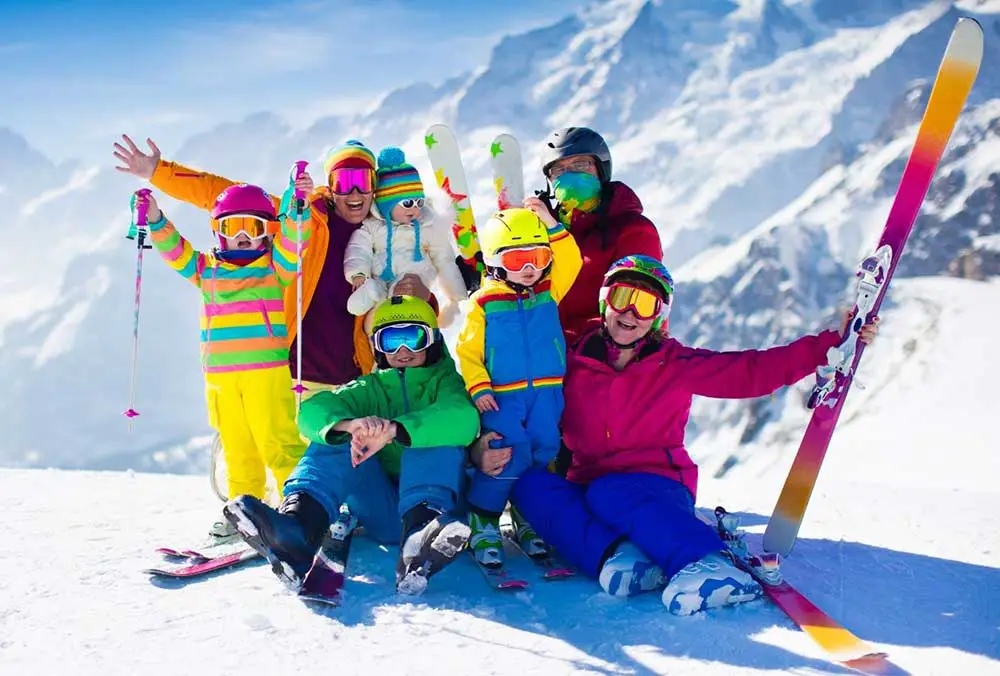
The main reason for this is that while skiing does take place at high altitudes and in often frigid conditions, it’s also incredibly active. Skiing is one of the most intense forms of exercise, a whole-body workout that requires immense dexterity and endurance.
As a result, skiers actually get hot, and an inappropriate wardrobe can cause overheating just as easily as it could cause hypothermia.
To make sure you’re able to avoid making key mistakes, it’s important to layer your clothing and choose appropriate options for each layer to make sure that you are comfortable, and can easily adapt to the prevailing weather conditions.
In this article, we’re going to look at what to wear for each layer, as well as some good options and characteristics to look out for in each piece of clothing. We’re also going to include some key tips, do’s, don’ts, and also give some estimates of prices to make sure you can focus on getting excited for your next trip!
Best Simple Ski Layering System
- Base Layers: For retaining body heat and wicking away moisture such as sweat.
- Mid Layers: Trap warm air, retain body heat, and insulate from cold external air.
- Outer Layers: Waterproof and windproof to protect against wind and snow, whether it’s falling, or you are.
Base Layers
As their name suggests, base layers form the skin-tight foundation of your clothing options for skiing and are typically worn in two distinct parts.
Base Top
The base layer top is a shirt that is typically quite tight fitting and is designed to trap body heat and wick away sweat and moisture to keep you dry as well as warm.
These shirts are often made of synthetic materials or merino wool, as they need to provide insulation without absorbing moisture. This is important because in cold weather sweat can freeze and actually increase your risk of getting hypothermia or becoming uncomfortable.
Base Bottoms
Base bottoms are leggings or tight-fitting trousers that sit below your salopettes or skiing trousers. It’s important to make sure they’re quite tight fitting so that they don’t affect the comfort of your salopettes, and they typically sit above the ankles and hug the legs and buttocks.
If the base bottoms are too long they can feel uncomfortable inside the ski boot, so absolutely don’t use ill-fitted base bottoms!
Base Layer Thicknesses
Base layers come in a variety of thicknesses and styles to allow you some options depending on what time of year you’re skiing and where you intend to do it.
Light
These very thin base layers are the lightest and most comfortable and are the same as those used for running and other exercises.
Typically these provide the least insulation and the most breathability which can be great for summer or low altitude skiing. They also dry quickly and wick away moisture more effectively.
Mid-weight
These base layers are a little thicker and make a good compromise between breathability and insulation.
Heavy
Heavy base layers are all about insulation and will help keep your core warm even in the harshest environments and highest altitudes, while still providing some wicking and breathability.
Base Layer Fits
There are a few main base layer fits available, again depending on preference and intended conditions.
Compression Fit - Compression fit base layers are tight and hug the skin closely, literally squeezing your muscles and body. They are designed to assist blood flow and movement, providing support to your muscles and insulating and wicking very effectively.
Some people find these uncomfortable but they are a great option for skiing as they give great ability to move effectively.
Fitted - Fitted layers are more similar to a regular shirt fit, and are not anywhere near as tight. This makes them a bit more of a relaxed choice and more comfortable for everyday wear, but less effective at wicking and assisting performance.
Soft/Regular Fit - These options are much more casual and are typically used for long-term comfort where the emphasis isn’t on maximal performance.
Main Base Layer Materials
There are two particularly common base layer materials, and these are;
Synthetic - Made fibres which are comfortable, relatively inexpensive, and designed to effectively wich moisture and be easily washed.
Wool - Wool is more traditional but is comfortable and warm, however, it doesn’t dry as quickly and isn’t as cheap as synthetic options.
Mid Layers
Mid layers quite sensibly sit between the inner and outer shell of your ski clothing, and are a flexible option designed to keep you warm and comfortable. Fleece and highnecked jumpers are common options, however, specially designed ski hoodies are also very common among younger skiers and freestylers.
Mid-layers can be as tight or loose as you like, depending on preference. However make sure that the layer isn’t so tight that it restricts movement, or too loose that it doesn’t insulate properly or gets in the way of your outer layer.
Naturally, in colder weather, a thicker more substantial mid-layer is required, while in warm weather (anything above -5 to 5 degrees Celsius) can use thinner mid-layers.
Anything above 5 degrees is considered very warm for skiing and this means you can remove your mid-layer, stowing it in your daysack, so you can put it back on if the temperature plummets.
Outer Layers
When it comes to skiing the most important layers are the outer layers, which are usually made up of a ski jacket and salopettes.
These are specially designed and cannot be easily replaced or replicated by non-ski-focused alternatives as they are designed with a host of features and cuts to make them perfectly suited for skiing.
These layers have very high waterproof ratings but are also very breathable, making them perfect for skiing as they keep the snow and moisture out while allowing your sweat to evaporate effectively.
Look for waterproof ratings of over 10kmm and breathability ratings of above 8kmm for the best performance possible.
Ski jackets are filled with important additional features such as hoods designed to work with ski helmets, well located and specially designed pockets for ski passes, and of course, the waterproofing, windproofing, and breathability previously mentioned.
They also often have sealable cuffs, elasticated bottoms to keep snow out of your pants should you fall, and often have room for emergency storage of snacks and supplies.
Salopettes/ski trousers are even more important because they are specifically designed to work with ski boots which are bulky and awkward. The best options will have good adjustability, pockets, waterproofing, and the ability to work with quality ski jackets.
The Issue with too Many Layers
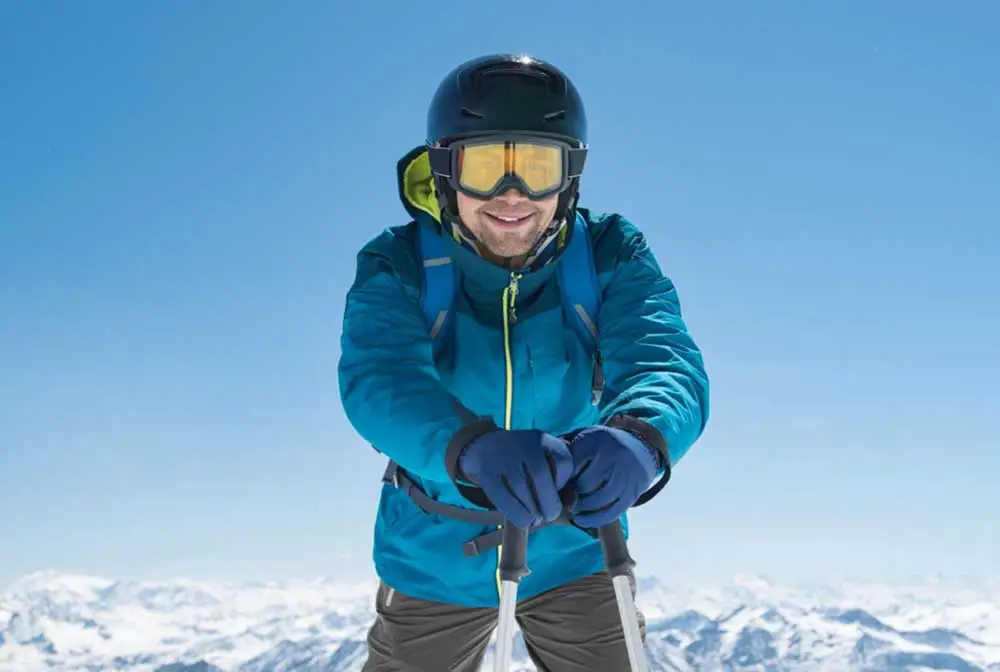
Adding too many layers will not make you warmer, as previously mentioned this will prompt heavy sweating which is the body’s way of cooling you down.
This combined with the cold temperatures creates a perfect storm of cooling which can be made worse by sweat freezing, making you colder rather than warmer.
This sweat build-up can also cause the wind to make you feel even colder, which is why 3 good quality layers are the sweet spot.
The bonus is that 3 layers are also manageable, making it easy to remove a layer and replace it depending on how you’re feeling and what conditions are like.
The do’s of Layering
Do;
- Wear a base, mid and outer layer
- Tailor your base layers to your environment and the weather
- Wear outer layers with high waterproofing and breathability
- Wear thick jackets in extreme conditions
- Air out and thoroughly dry all your clothing each day
The don’t of Layering
Don’t;
- Wear more than 3 layers of clothing
- Wear wet clothes
- Use normal, non-ski focused alternatives
- Use poor quality materials like cotton which absorb sweat and moisture
How to stay warm while skiing?
- Wear 3 layers!
- Use dry of fresh clothing
- Eat plenty of food (Some say Alpine/Downhill skiers need double or even three times the normal amount of daily calories depending on difficulty and time on the slopes)
- Wear proper ski socks
- Keep your extremities (fingers and toes) relaxed and move them as much as possible.
- Wear proper ski gloves
- Use a ski mask/gaiter
- Wear ski goggles
- Use a properly insulated ski helmet
- Don’t leave any skin exposed to the elements
- Bring snacks
- Use hand/boot warmers
- Bring a flask of warm drink in your bag
- Keep skiing!
How to Keep your hands Warm and Protected?
Our hands are some of the hardest parts of the body to keep warm, and this is even more difficult when skiing as they are often clenching onto ski poles and moving around very little. Use these tips in order to keep your fingers from going numb and becoming sore or painful.
- Always put your gloves on before you head out and don’t remove them until you’re back indoors
- Use waterproof ski gloves
- Use gloves liners
- Don’t ‘grip your ski poles too tightly
- Use hand warmers
How to Keep Your Feet Warm and Dry?
Much like our hands, our feet are often very difficult to keep warm, particularly if you’re someone who suffers from poor circulation.
While skiing our feet are often strapped up tightly within the ski boot and while they may move around a little, its common for skiers to clench their toes and allow their feet to become numb and cold. Follow these tips in order to keep your feet warm and comfortable during the longest ski days…
- Use thin, properly designed ski socks
- Don’t overtighten your ski boots (if they don’t fit properly, DO NOT SUFFER IN SILENCE. Head to the store and get a replacement size that will improve your skiing and your comfort)
- Unbuckle or loosen your boots during lunch breaks to alleviate some pressure but DO NOT remove the boots entirely until you’re back at the chalet as swelling may make it difficult to put the boot back on!
- Don’t clench your toes or feet, even on challenging sections of the piste!
- Always use dry socks
What do Ski Clothes Cost?
Ski clothes may be a little more expensive but they are packed with features that will keep you safer and more comfortable on the mountain, and there are some surprisingly affordable options available for beginners.
It’s also sometimes possible to rent too, which may be worth looking into if you’re going for a one-off trip.
Generally, prices are as follows;
- Ski Jackets / Ski Trousers - $200 // €200
- Gloves - $40 // €30Goggles - $50 // €50
- Helmet - $60 // €40
The cost of thermals and other layers can vary significantly but a whole set of base layers can come in at around 70 dollars, while mid-layers can be anywhere around 65 dollars.
Second-hand options are sometimes worth considering if in good shape but never get secondhand helmets or safety equipment.
- How to Train in the Summer for Cross-Country Skiing: Off-Season Strategies for Peak Performance - April 19, 2024
- Ski Lift Ticket Prices in Colorado [For 2024 Season] - January 26, 2024
- How to Choose Classic Cross-Country Skis: A Guide for Beginners - November 10, 2023

